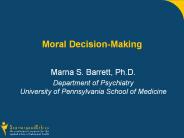Attachment-Related Variables Predict Moral Mindset and Moral Action - PowerPoint PPT Presentation
1 / 1
Title:
Attachment-Related Variables Predict Moral Mindset and Moral Action
Description:
Darcia Narvaez, Jeff Brooks, Brad Mattan FIGURE 1. Study 1 Path Model for Integrity with Unstandardized (Standardized) Factor Loadings: Early life effects predicted ... – PowerPoint PPT presentation
Number of Views:50
Avg rating:3.0/5.0
Title: Attachment-Related Variables Predict Moral Mindset and Moral Action
1
Attachment-Related Variables Predict Moral
Mindset and Moral Action
Darcia Narvaez, Jeff Brooks, Brad Mattan
FIGURE 1. Study 1 Path Model for Integrity with
Unstandardized (Standardized) Factor Loadings
Early life effects predicted agreeableness and
openness, moral mindsets. Agreeableness and moral
mindsets predicted integrity. Note.
Solid lines represent significant factor/path
loadings. p lt .05 FIGURE 2. Study 1 Path Model
for Helping Less Fortunate People with
Unstandardized (Standardized) Factor Loadings
Early life effects predicted agreeableness and
openness, moral mindsets. Openness and engagement
identity predicted action for less fortunate.
Note. Solid lines represent significant
factor/path loadings. p lt .05
FIGURE
3. Study 2 Path Model for How Attachment and
Values Influence Identity with Unstandardized
(Standardized) Factor Loadings Bunker mindset
was negatively related to secure attachment and
core value lifestyle but positively to value
intrusion. Wallflower mindset was related to
fearful attachment and value intrusion.
Engagement and imagination mindsets were related
to core value lifestyle. Note. Solid
lines represent significant factor/path loadings.
p lt .05
- ABSTRACT
- We examined the predictiveness of triune ethics
theory (Narvaez, 2008) which postulates that
three neurobiological mindsets underlie moral
action security (bunker externalizing or
wallflower internalizing), engagement, and
imagination. Ones preferred mindset is
postulated to be influenced by early life
experience which shape neurobiological systems
represented in attachment as well as personality
(agreeableness, openness). We developed identity
measures of each ethic and, in two studies,
tested their relations to variables representing
early life experience, personality and moral
action. - INTRODUCTION
- Early life experience has longterm effects on
stress response (Lupien et al., 2009), social
brain development (e.g., Schore, 2001), openness
(Greenspan Shanker, 2004), empathy,
agreeableness, and conscience (Kochanska, 2002). - Triune Ethics Theory (TETNarvaez, 2008 2009)
posits that moral functioning depends on
emotional systems shaped during sensitive
periods. Three moral orientations reflect evolved
neurobiological propensities - ETHIC OF SECURITY Self-protective morality.
Emerges from stress reactivity and
fight/flight/freeze responses. - ETHIC OF ENGAGEMENT Relational presence based in
relational hormones. Involves emotional systems
that drive intimacy and compassion - ETHIC OF IMAGINATION Reflective abstraction.
Source of deliberative reasoning based in
recently evolved parts of brain (e.g, prefrontal
cortex) - HYPOTHESES
- 1. Personality factors are predicted by proxies
for early experience (secure attachment,
humanistic orientation, basic needs effectance
predict agreeableness and openness). - 2. Moral mindsets are differentially predicted by
proxy measures of early experience (secure
attachment for engagement and imagination,
insecure for security). - 3. Ethical identities have different attachment,
personality and moral action signatures
(engagement ethic predicts moral action and core
values enactment security ethic predicts value
imposition and negatively predicts moral action).
RESULTS AND DISCUSSION (Figures 1 and
2) Regressions showed that two personality
variables (Agreeableness Openness) and two
moral orientations (Engagement Imagination)
related to moral outcomes. Structural Equation
Modeling (SEM) further investigated relations.
Factor analysis showed attachment-related
avoidance, effectance, and humanism formed a
latent construct (we called early life effects).
Early life effects predicted personality and
moral orientation. Personality and moral
orientations predicted moral outcomes. Integrity
was predicted by agreeableness and engagement and
imagination identities. Moral Action was
predicted by engagement identity and
openness. STUDY 2 METHODS AND
MATERIALS Participants were 191 undergraduates.
They completed an online survey. We measured
subtypes of the Security Ethic -Bunker
(combative and domineering) -Wallflower
(withdrawn and timid) Relationship
Questionnaire (Bartholomew Horowitz, 1991) was
used to measure attachment style secure,
dismissing, fearful, preoccupied We developed
and factored two measures of value
implementation (a) Core Value Lifestyle
(CVL) How much one consciously make decisions
based on core values in certain areas (e.g.,
friends I cultivate) (b) Value Intrusion
How much one thinks that others should embrace
ones own values (e.g., I want authorities to
ensure that others live the way I
live.) RESULTS AND DISCUSSION (Figure
3) Bunker security ID was related to insecure
attachment, value intrusion, and lack of core
value lifestyle (CVL). Wallflower security ID
related to insecure and fearful attachment and
value intrusion. Engagement ID related to secure
attachment and CVL. Imagination ID related to
non-value intrusion and CVL. GENERAL
DISCUSSION Over both studies, the hypotheses
were supported. Morality in college students is
also influenced by early life experience,
affecting identity and moral behavior. The three
ethical mindsets (security, engagement,
imagination) build on attachment orientation,
relate to personality factors, and predict moral
action, and value implementation. These findings
support the notion that security ethic represent
a self-focused mindset due to detrimental early
life experience, resulting in less moral action
and behavior. CONCLUSION The results provide
preliminary evidence that early life experience
shapes brain and body systems for preferred moral
functioning as triune ethics theory postulates.
For optimal moral development, good early life
experience is needed to foster the neurobiology
of compassion and imagination. CONTACT Darcia
Narvaez, dnarvaez_at_nd.edu































